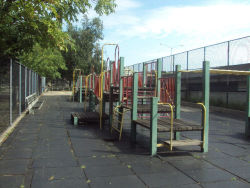Percy E. Sutton Playground
Percy E. Sutton Playground
What was here before?
This land is just south of what was once known as the Harlem Speedway, which opened in 1898 and ran along the Harlem River from East 155th Street to Dyckman Street. Popular for carriage racing, it was an offshoot of Harlem Lane, a roadway which began as a Native American trail and would later become Saint Nicholas Avenue. In 1915, the Harlem Speedway became the Harlem River Parkway and merged with the East River Drive (today’s Franklin Delano Roosevelt Drive) in 1937, allowing for easier vehicular access to eastern Manhattan, the Triborough Bridge, and Cross Bronx Expressway.
How did this site become a playground?
The original plot of land was acquired by condemnation in 1893 by the City and assigned to NYC Parks. Two additional parcels were added in 1947, one by deed of gift and the other was proposed to be part of West 153rd Street before being reassigned to Parks. This site was originally called Harlem Lane Playground.
The playground’s central promenade provides views of the Macombs Dam Bridge and Yankee Stadium. The playground was renovated in 1993 and is currently under construction, along with adjacent Frederick Johnson Playground. To be completed in 2022, the reconstruction includes replacing Harlem Lane Playground’s public restroom with a new one closer to where the playgrounds meet. There will be a seating area, half-court basketball courts, a fitness area, lawn spaces, and a bikeway linking to the city’s larger greenway system.
Who is this playground named for?
In 2021, as part of the second phase of NYC Parks’ initiative to expand the representation of African Americans honored in parks, this playground was named for civil rights leader, elected official, and businessman Percy E. Sutton (1920-2009).
The youngest of 15 children, Percy Ellis Sutton grew up on a farm in San Antonio, Texas. His parents were entrepreneurs and educators, and his father was a high school principal. At age 12, he ran away to New York, where he slept under a sign at 155th Street, the northern terminus of this park. The following year he was beaten by a police officer in Texas while passing out NAACP pamphlets.
He attended Prairie View A&M, Tuskegee Institute and Hampton University before he enlisted in the armed forces during World War II. He served with the Tuskegee Airmen, for which he earned combat stars. After the war, he enrolled at Columbia Law School before graduating from Brooklyn Law School. While serving in the Air Force after law school, Sutton became the first Black Judge Advocate General (JAG). In 1953 he opened a law firm in Harlem. A Freedom Rider, Sutton was arrested in Jackson, Mississippi in 1961.He represented Malcolm X and, after his death, his family for several decades.
Sutton won a New York State Assembly seat in 1964, and in 1966 he replaced Manhattan Borough President Constance Baker Motley when she was appointed a federal judge. Reelected twice, he was the longest serving Manhattan borough president and highest ranking Black elected official for more than ten years. As Manhattan Borough President, Sutton was instrumental in starting the New York City Marathon. In his 1977 run for Democratic mayoral nomination, he became the first Black man to run for mayor of New York City.
In addition to his legal practice and political career, Sutton founded Inner City Broadcasting, which owned several radio stations across the country, including WLIB-AM and WBLS-FM. In 1981, Inner City bought and renovated the legendary but struggling Apollo Theater and secured its landmark status. Sutton also created and executive produced the hit television show, “It’s Showtime at the Apollo.” He earned numerous awards, including the Congressional Gold Medal and the NAACP Spingarn medal.
Check out your park's Vital Signs
Clean & Safe
Green & Resilient
Empowered & Engaged Users
Share your feedback or learn more about how this park is part of a
Vital Park System





